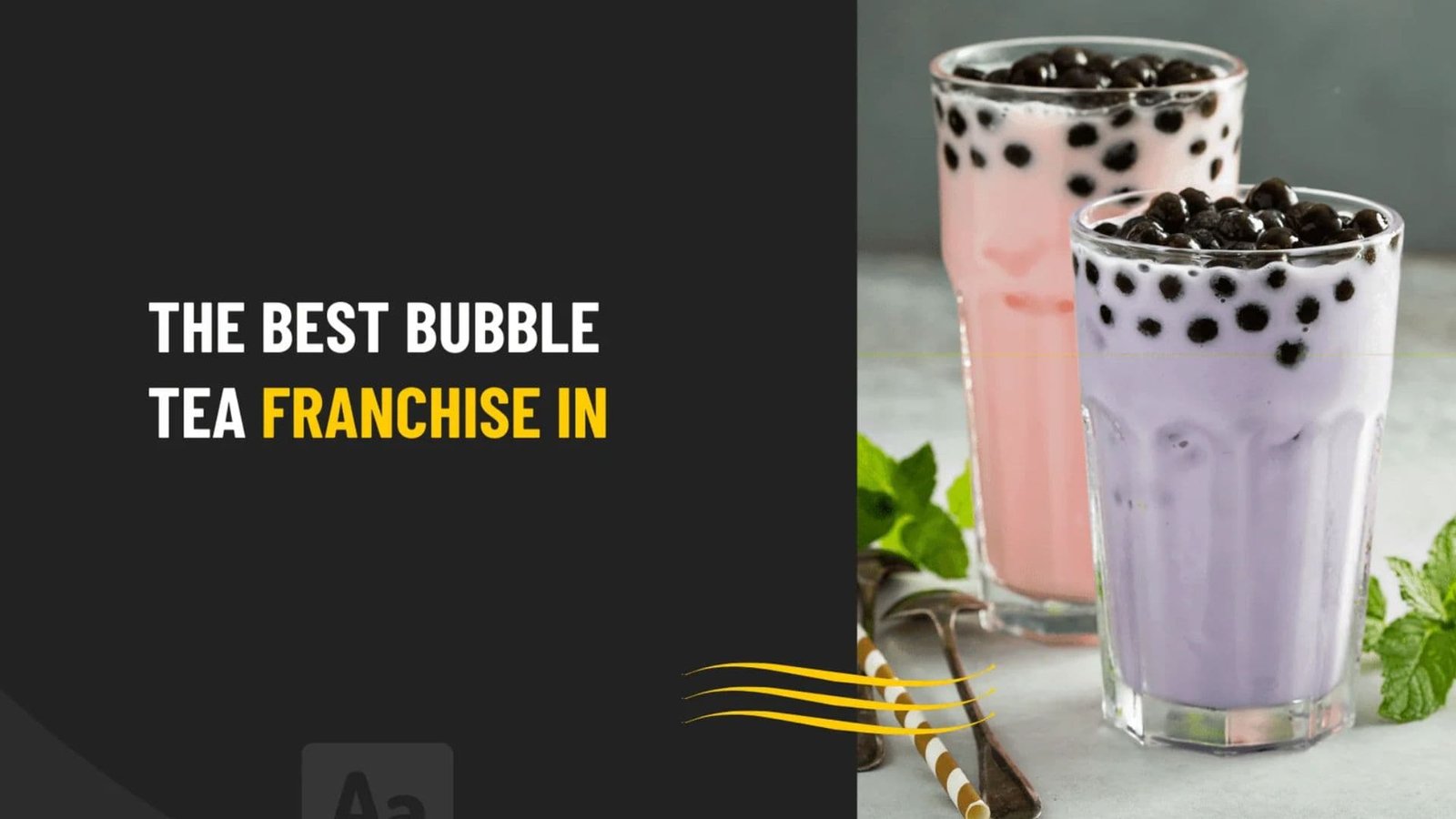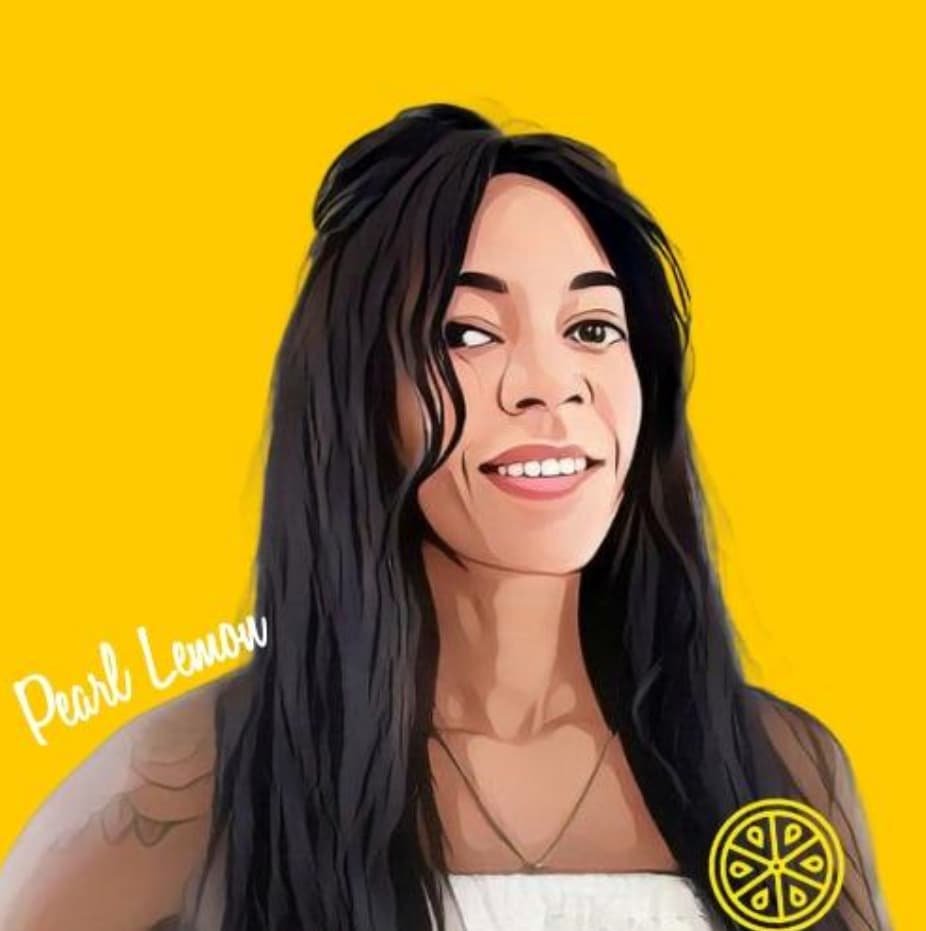In contemporary times, we have a lot of beverages to choose from due to the expansion of the food & beverage industry, technology providing us delivery apps and food apps, and cultural cuisines just popping everywhere in your neighborhood.
You name it, regular coffee, juice, tea, frappe, shakes, smoothies, milkshakes, milk, chocolate drinks, beauty drinks, sparkling drinks, mocktails, cocktails, beer, wine, etc.
We’ll probably be done by tomorrow if we go into detail about each type. That’s for sure!
However, one rising beverage that is quite the hit with people of all ages and generations is what we call– milk tea, boba tea, or bubble tea. And we’re betting you, our dear reader, have already tried it one way or another.
But we’re curious, how did bubble tea all start?
Well, why don’t we find out?
Everything To Know About Tea History
A bubble tea wouldn’t be bubble tea without tea. Quite the tongue twister, right?
But it’s primarily true that bubble tea wouldn’t exist without the ingredient: tea.
But where did tea come from?
The Imperial Chinese Drink
You might think the tea concept came from Britain, but it wasn’t. Yes, even if Brits have been consuming tea for almost 350 years, we aren’t the first ones to discover it.
The idea of “tea” originally came from China.
It is indeed quite a fascinating story if you ask us. They say it was way back in 2737 BC that the Chinese emperor Shen Nung was resting himself below a tree. His servant was boiling water as part of the picnic he was having when suddenly leaves from the tree fell on the boiling water.

Source: Celestial Seasonings
The emperor, being a famous herbalist in his time, decided to drink the accidental infusion. Fortunately, the tree he was resting on was a Camellia Sinensis or what we call today a tea plant.
The lucky emperor was indeed reckless as it would’ve been a poisonous tree. But here we are today, enjoying their discovery.
Nobody knows the truth behind this legend, but historians had discovered that tea originated from China many years before it even became a staple in the West.
In fact, tea containers have been found in archaeological findings dated back to the Han Dynasty (206 BC – 220 AD). Only under the Tang Dynasty (618 – 906 AD) did ” tea ” become a national drink for the Chinese.
It was so popular back then to the point that the one called “Sage of Tea”, Lu Yu wrote the first book entirely about tea. Shortly after, tea was introduced to Japan. This happened through Japanese Buddhist monks that travelled to China for their education.
Ever since then, tea drinking has become a vital part of Japanese traditions. It became prevalent through their Tea Ceremonies under Zen Buddhist philosophy. Many other Asian philosophers also used tea as an object for their wise sayings if we dig deeper.
Europe’s Tea Acquaintance
Europe was lagging behind at this point in tea history.
The first mention of tea as a beverage among Europeans occurred in the late sixteenth century. They were mainly Portuguese traders and missionaries who lived in the East. You know, the typical colonialism history in books where the Spanish and the Portuguese travelled seas to find spices and more.
However, it was not the Portuguese who brought back commercially imported tea to their country, even if they did bring back tea samples. This was because the Dutch began pirating on Portuguese trading routes in the East and hauled goods for exports.
In 1606, the first shipment of tea from China to Holland was shipped via Java, where they had established a trading post by the turn of the century. But due to its high price, tea remained a drink for the wealthy in continental western Europe after becoming a fashionable drink in Dutch society.
The Royalties of Britain
As a nation that had been hesitant to embrace continental trends, Britain had yet to become a nation obsessed with tea. Sailors on ships likely brought tea home as a gift since the British East India Company had a monopoly on importing goods.
Nonetheless, tea is first mentioned in this country in an advertisement from 1658 in a London newspaper, Mercurius Politicus. It wrote that at Sweeting’s Rents in the City, a coffee house was selling ‘China Drink, known as Tcha to the Chinese, and Tay to other Nations.’
Coffee houses were first established in London in 1652, and this advert suggests that tea was still somewhat unknown to most readers. Hence, it seems reasonable to assume that the drink was still somewhat of a novelty and piqued the interest of most people.
But one royal marriage changed the course of tea in Britain. As a result of Charles II’s marriage to Catherine of Braganza, tea history in Britain underwent a massive shift.
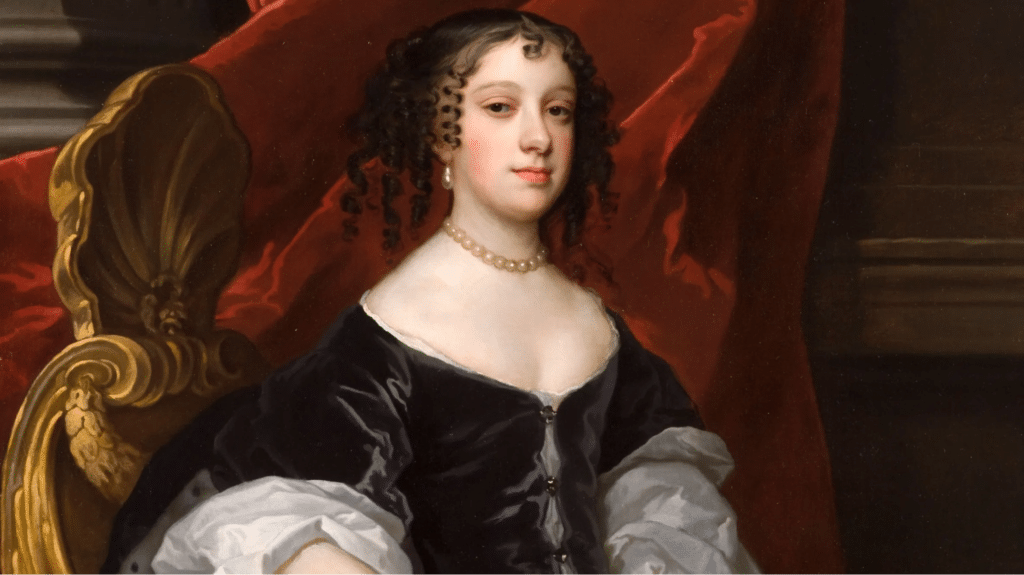
Source: History of Royal Women
The Portuguese princess Catherine of Braganza was addicted to tea. Tea became fashionable under her influence, first at court and then among the socialites.
The East India Company took advantage of this by importing tea into Britain for the first time in 1664, ordering 100lbs of China tea from Java.
Ever since then, tea became a staple for high-class nobility and, later on throughout time, became a staple for everyone.
The Beginnings of Bubble Tea
Now that you have the beginning of tea, why don’t we start learning about Bubble Tea?
Let’s all go back to the 1940s, where everything about bubble tea started.
You’ll probably remember that this age was the same time World War II was unravelling every nation in chaos. Nations are falling, economies are burning, and industries are in turmoil. Of course, there’s a lot of negativity right there about the war.

Source: VoaNews
However, WWII was also an eye-opener to many people on what they wanted to do the most in life. And so, after the war, many people innovated things that made other people happy– some of them innovated food that warmed the heart.
Chang Fan Shu– a former mixologist in Taiwan under Japanese rule during WWII– opened up a tea shop selling extraordinary “Shou Yao”, or hand-shaken tea made with cocktail shakers in 1949.
His beverage was described as silky and rich with fine air bubbles. Today, shou yao plays an essential role in bubble tea. You can think of it this way: Without shou yao, we won’t be enjoying bubble tea.
At that time, cold drinks were not common, and Taiwan had just begun to embrace the concept of consuming food and beverages for pleasure. Later on, iced drinks became more popular on the island.
According to Tseng Pin Tsang, a Taiwanese food historian, “the trend of tea beverages prospered together with the rise of the leisure food trend in the 1980s as Taiwan was experiencing rapid economic growth”.
“In addition to the industrial pre-packaged tea products, there were more tea shops on the street and tea restaurants in the suburbs”, he added.
From here, there are two stories that the Taiwan streets acknowledge in the birth of bubble tea. Nobody knows who’s real or not but let’s check them out both.
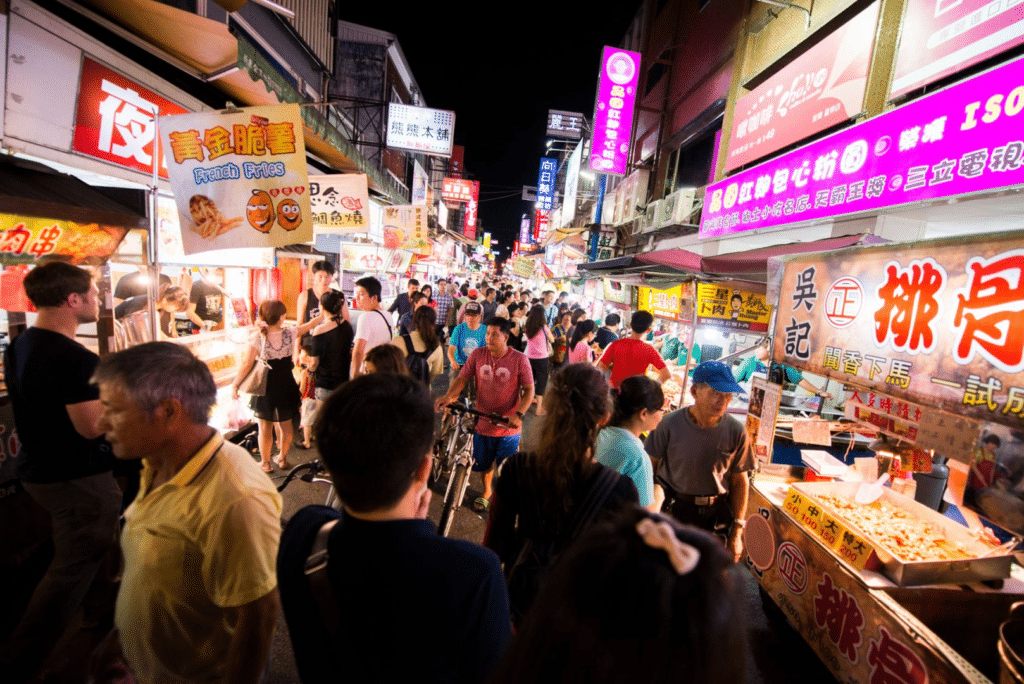
Source: Outpost Magazine
The Start of A Fruitful Business
Years later, in 1986, Tu Tsong He decided to ride the tea shop trend as a springboard for his new business venture. He started a green tea business that would later start the trend of having “bubbles” inside bubble tea.
Tu desperately needed a new idea to set his tea shop apart from the competition after his previous hot pot restaurant failed. He owed TWD 4 million or $133,000 and had no idea what to do.
The businessman recalled visiting the Yamuliao wet market in Tainan when he saw fen yuan or tapioca balls, a traditional snack he had admired from childhood.
He then had a fantastic idea of adding some fen yuan to his served green tea. He thought it was fun to see the white fen yuan in the bubble tea while being translucent when added to the golden green tea.
The fen yuan reminded him of his mother’s pearl necklace; thus, he coined the beverage with the name ‘zhen zhu lu cha’ or pearl green tea.
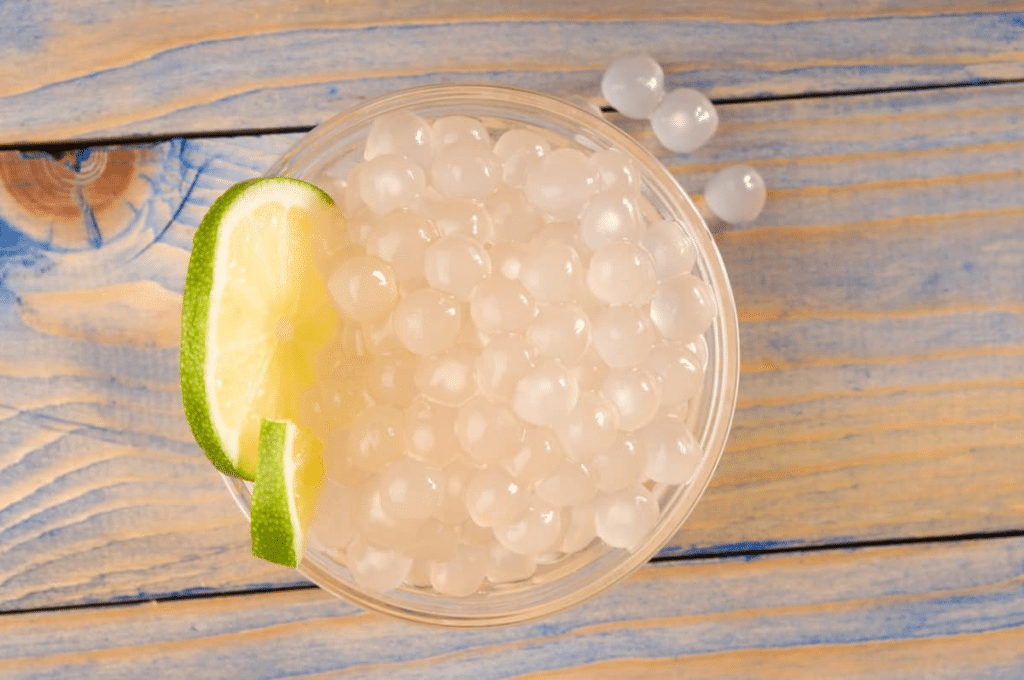
Source: Foods Guy
However, he did not stop at that. People loved the beverage, but he thought there was something more he could do with the drink. To give the classic bubble milk tea a richer taste and a chewier texture, Tu experimented by adding black tapioca balls to the bubble tea.
Tu remembers that the black bubble tea balls were larger than the manufactured straws. So their customers had to make use of spoons to get it out. Later, they worked with a plastic factory to produce straws that would fit the tapioca balls.
Tu Tsong He’s bubble tea shop, Hanlin, started its operations in October 1986.
The masses had well-accommodated bubble tea, and soon, they sold more cups than they could imagine. This prompted their success in food and beverage history and paved the way for multiple business expansions.
There are now about 80 Hanlin branches throughout Taiwan and franchises in the US, Canada, and mainland China.
The Mix People Loved Everywhere
The other story started in 1988 when a staff meeting was in place at Chun Shui Tang. Lin Hsiu Hui, a product manager at the said company, was said to create the first glass of bubble milk tea.
Back then, mixing drinks or things into your drink was popular, so she tried mixing the tapioca balls she brought into her Assam tea and enjoyed it.
Lin said, “Everyone at the meeting loved the drink, and it quickly outsold all of our other iced teas within a couple of months.”
The business company Chun Shui Tang also claims to have introduced foam tea– shaken in a cocktail shaker– to the world first.
A Legal Dispute For History
It is no secret that the bubble tea rivalry has grown heated over the years. It all started with a 10-year lawsuit that was filed in 2009. After much ado, the fight was finally settled in 2019, ending in a friendly but disappointing way.
It was ruled that anyone or any shop could make bubble tea. So there was no point in debating who created it in the first place.
Businessman and tea lover Tu Tsong He, said that the lawsuit was only a fight for truth but nothing so personal that it would destroy friendships formed in the tea industry. He later stated that they would let the people who drink bubble tea decide who is the first real drink maker.
So dear reader, let us ask you– who do you think made it?
Coining The Term “Boba”
Even if the origination of bubble tea had no winner, its nickname had undisputed origins.
We often call it “boba,” which is generally synonymous with bubble tea. But actually, the word “boba” originated from the appearance of large black tapioca pearls added to the drink.
A lot of locals believe and agree that a hawker in Tainan coined the term “boba.” The man was said to be inspired by Hong Kong movie star Amy Yip’s nickname in the film industry, which was “Boba” at the time. When loosely translated, the movie star’s nickname was “champion of breasts.” Funny, right?

Source: 8 Days
The hawker called these larger tapioca balls “boba” to distinguish them from tea shops’ smaller fen yuan.
It’s Also Called Other Names
Well, nowadays, some may know boba tea by different names.
It’s actually abundant throughout this content. But aside from the variations, we have been using, there are also other names it’s known for.
Let’s try to take a look at them one by one.
- Boba – frequently used on USA’s west coast
- Boba Nai Cha – Taiwanese for bubble tea
- Bubble Tea – English for bubble tea
- Milk Tea – commonly used by Asians
- Tapioca Juice – Japanese calls boba this term
- Tapioca Ball Drink – a slang for people who don’t know the term boba
- Pearl Shake – another slang for people who have yet to discover the term boba
- Black Pearl Tea – generalised by people who think black pearl tea flavour is the coined term for bubble tea
- Zhen Shu Nai Cha – Chinese for bubble tea
There may also be other terms for it in other different places, but these ones are the most abundantly used all over the world.
Now isn’t that interesting?
Taiwan’s Self-Confidence & Identity
As we’ve mentioned, there’s more to Taiwan’s innovation of bubble tea. It wasn’t just about the taste and the texture. It was about life changes that were going on at that time.
Taiwan was undergoing a shift from the old to the new age. Their society was slowly building after provocations from China, and people were looking for happiness and pleasure in most things.
One might even say that bubble tea is an infusion of modern and classic age-old culture. And nowadays, it continues to do so for Taiwanese people. It gives them this sense of nostalgia for the times they were able to progress and move on.
Tseng then reiterates that while locales were in the process of making two traditional ingredients for boba– which were tapioca pearls and tea– they bonded over the richness of their culture and history.
“Bubble tea is a successful example of recreating a traditional food. It has become a symbol of Taiwanese’s self-confidence and identity.”
Bubble Tea’s Introduction To The World
But the bubble tea trend did not stop in Taiwan. It flew out of the country and into the streets of foreign lands– in different ways, actually.
A National Issue Turned Stage
One should respect bubble tea not just because it is food but also because they are a symbol of Taiwan’s culture and history.
Something that Taiwan’s former Defence Ministry did not understand well.
While the remains of the war were still not entirely erased in the minds of their public officials, Taiwan’s government proposed to purchase more weapons for the country. It was in preparation for China’s attack against their sovereignty.
However, weapons were very costly, and the people weren’t convinced even if they were already threatened to be bombed by 600 missiles from China.
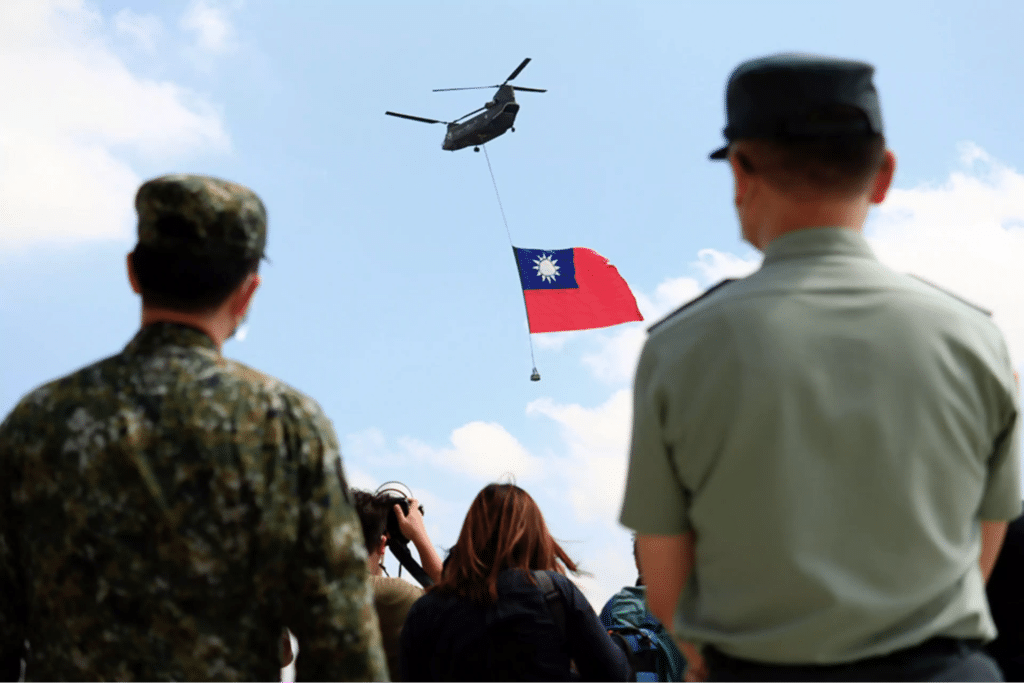
Source: Council of Foreign Relations
To persuade them, the Defence Ministry started handing out leaflets that said if locals abstain from drinking a glass of bubble tea per week for the next decade, they could save up to pay for the purchase.
This campaign hit the locales as very offensive and immediately backfired on the government’s stand. The issue stirred heat in the country and united bubble tea makers, suppliers, drinkers, and avid lovers alike.
Easy Way, a bubble tea chain in Taiwan, stated in a press conference held for the opposition, “Why don’t you ask people to skip drinking Coke instead?”. In honesty, it was an irrational argument. However, what they were trying to say was that the government was stopping them from consuming something that the Taiwanese people were proud of making.
It was a product that boosted their economies and gave people jobs, opportunities, and pleasure.
This iconic news was labelled as the “Bubble Tea for Arms” by their local media.
However, certain scholars suggest this issue was more than just an internal conflict in the country. It set the stage for bubble tea to be introduced to the world as this particular issue made it to BBC News.
Touch Down U.S.A
You can also say that bubble tea started with its first introduction to the world in the “Land of the Free” – or what we’d like to call the United States of America.
Before the world war, Asians, Southern, and Eastern Europeans were restricted from entering the country. But a few more years after the war, the US government approved the Immigration and Nationality Act of 1965, which changed people’s migration patterns.
As a result, Taiwanese immigrants flowed like water between the 60s and 90s. These immigrants then settled and built families in LA and California. In fact, in 2008, these states had the most significant number of Taiwanese immigrants in the country.

Source: Media Storehouse
In a few years, Taiwanese Americans introduced boba culture to other Asian Americans through their schools, neighbourhoods, and social circles in the early ’90s in these areas. Bubble tea was initially encountered primarily in Taiwanese restaurants and served as an afterthought in the LA area. Something that can be considered a dessert– like ice cream after eating a salty or sour dish.
It was in the late 1990s that the first stand-alone boba shop was established in Arcadia– a small town in Louisana. In the early 2000s, several shops devoted to the drink opened consecutively. Among the first businesses were Ten Ren, Quickly, Tapioca Express, and Lollicup, which all had Taiwanese owners.
These milk tea shops and the boba tea they served were almost identical. Perhaps the business trend initiated more Taiwanese immigrants to open up and let more people taste the refreshment from their hometown. It is a national treasure for them, after all. Most people back then associated these shops with old-traditional board games, Asian pop songs, and young ones hanging out on some cheap furniture from a famous store. It was like an Asian coffee shop for them.
But aside from that, boba tea shops were places of solace back then. They were places where friendships began, familiarity took place, and discrimination wasn’t an issue. There you feel like you belong no matter who you are. And people loved that amidst the crazy and cruel world. It was more than just about the drink– well, primarily because the boba teas back then tasted the same due to the shops having the same supplier.
Boba shops were indeed rampant, but not everybody accepted them. It was only when the 1st AZN era (“Asian Era”) came– which started in the late 1990s– did boba tea became widely accepted.
Due to an increase in people accepting Asian American pop culture, things like anime, Asian idol groups, and boba tea were rampant during that age. It made Asian immigrants feel– for the first time– that they have a culture they don’t need to be sorry about.
If boba teas were sold for only $1 in California back then, in today’s market, the average price is now $3- $5. But unlike before, milk teas are now more richly sourced. They now vary in tea, use powdered non-dairy creamers, high-grade sugars, more fresh milk (even skimmed milk is an option now), and more pearls!
People recalled that bubble tea wasn’t like that before. It was more about having an affordable drink that was tasty and refreshing. The generations of today have definitely taken a different turn on that.
Investment For The U.K.
Even though national issues and historical occurrences played a role in getting bubble tea into the global market, Assad Khan was a key figure in its introduction in a different land. Specifically in the United Kingdom.
Assad was a former British investment banker that is well-known for owning one of the largest homegrown bubble tea brands in the United Kingdom.
While staying in New York City, Khan had his first bubble tea in 2009. His first cup was that of taro bubble tea, and he was surprised at what flavours were brought to his palate.
The smoothness of the tea and the chewiness of tapioca pearls were a mixture to die for. It was a unique hybrid dessert that he knew everyone would love back in his hometown.
Of course, bubble tea was a hit across Chinatowns in overseas countries. However, it wasn’t that much of a trend among people outside Asian countries. There, he saw an opportunity, a gap in the market he could fill. Khan decided to quit his investment banking job and poured his luck and soul into Bubbleology in 2011.

Source: Shopping in Birmingham
The store was introduced in London’s chic Soho area. Its concept was formed around a rainbow-coloured logo and enthusiastic staff members wearing lab coats.
From then on, bubble tea was more than just a traditional drink in Taiwan or Chinatowns– it turned into a fashionable lifestyle drink in the UK on par with coffee.
The Rise of Bubble Tea
Now that boba tea has landed in the streets of the United Kingdom and the United States of America and has been recognised by locales, the rise of its popularity has become rampant.
Bubble Tea In Taiwan Today
Since bubble tea is popular in Taiwan – as we mentioned previously – it’s not surprising that the business thrives throughout the country.
Taiwan’s official banquet drink, “bubble tea”, received an emoji in 2020 and is now considered an “icon” as it slowly dominates the beverage market. It even celebrates an informal national holiday on April 30.
The popularity of bubble tea goes beyond its taste. For the world, it represents Taiwan’s existence and is a cultural icon.
In fact, Taiwan’s authorities are proactively cultivating its soft power today. Research and development are supported by the state-funded Food Industry Research and Development Institute, which utilises the said state funding to ensure technology transfer from private companies to the institute.
A good project they have started is finding a way to store bubble tea pearls or tapioca balls at room temperature. This would be of great help among business owners since this ingredient is commonly frozen all the time.
If they succeed in this research, this will also reduce their energy consumption.
Aside from that, Taiwan’s bubble tea industry is also being promoted and increased internationally through marketing policies implemented by the government.
These policies include bubble tea exhibitions, forums, pavilions, online seminars, and even local events aiming to build a “Bubble Tea Alliance” where industry players can share their expertise.

Source: TIME
The Alliance has grown and strengthened Taiwan’s dominance in the global bubble tea market in the last three years.
We guess it’s safe to say that this Alliance is a monster that slowly and surely dominates the market.
As of date, bubble tea is not only a beverage for Taiwan. It is a form of gastro diplomacy that leaves a mark on everyone. This drink is an innovative symbol and an ingenious item that signifies how Taiwan, a small east Asian Island, can dominate and take the world by storm.
Bubble Tea in USA Today
Bubble tea became so popular that other institutions started teaching how to make it by the era of the 2000s. After that, consumer interest in bubble tea was renewed in the early to mid-2010s thanks to the new school of bubble tea shops, popularised by the success of businesses in the market.
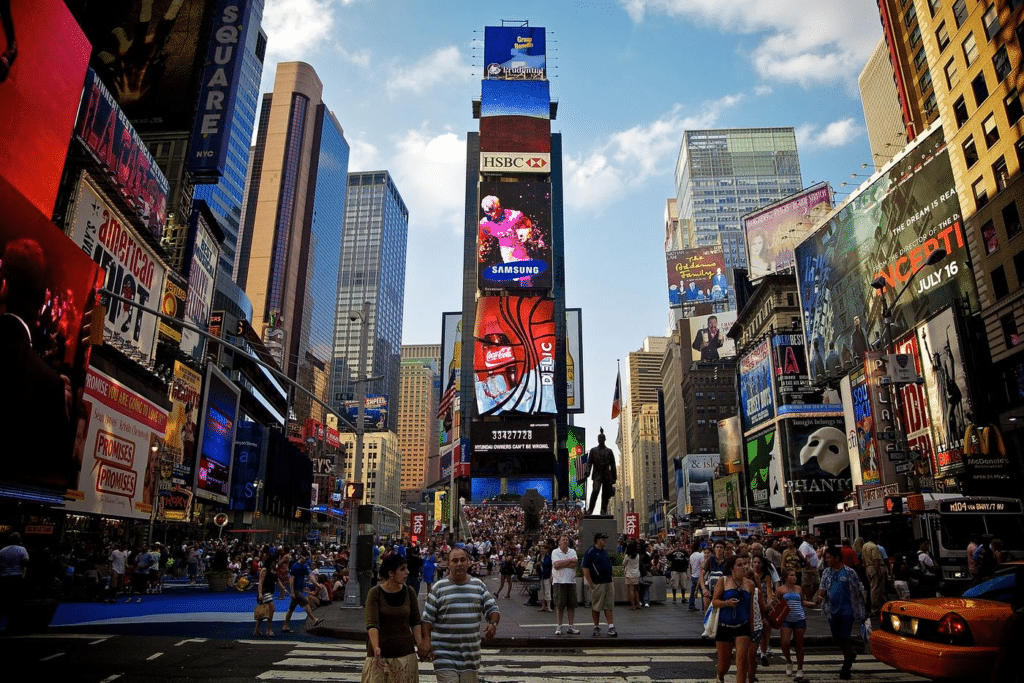
Source: The Observatory of Economic Complexity
“Bubble tea” and “boba tea” have seen steady interest increases over 2012, with steeper increases over the past few years. And there were ups and downs to that. In fact, way back in 2017, The New York Times wrote about bubble tea’s increasing mainstream popularity, describing Asian Americans as being displeased with the current trend and calling these people “blobs’.
The business trend skyrocketed to a point where by the year 2021, there were approximately 3,392 boba shops in the USA, with Garden Grove, California, as their boba capital. But still far from the market rise of coffee shops today.
But just like any other business, the boba tea market in the USA has its rivals, whether direct or indirect. One direct competitor is the classic coffee shop, where different drinks and refreshments may be sold. When you compare their trends, it is adamant that bubble tea has a long way to go.
But there is a closer competitor for bubble tea businesses in the USA, according to research experts. The rise of Chinese-American restaurants is a significant threat to this business in the US. These stores are consistently being opened by accomplished Chinese Americans that grew up in the land or have moved into the country for their studies. Unlike traditional Asian restaurants run by century-old cuisines, these restaurants are driven to open because of business trends and investments.
This is the opposite of how bubble tea businesses started way back then. Those shops were operated by immigrants and were selling boba tea to earn a profit, save money, and survive in the US.
Still, the bubble tea trend continues to thrive in this country, with everyone innovating one way or another.
In fact, even international companies have penetrated the US boba market. Tiger Sugar, a leading boba company in Taiwan, has made its way into the USA. Aside from that, first and second-generation Asian Americans are opening up new bubble tea stores in their eyed business area.
Today, these new businesses and entrepreneurs in the market are taking Western influence and taste into their products so that they can adapt. They have levelled up their products so people will continue patronising bubble tea.
Bubble Tea in UK Today
Following its success in South-East Asia, boba tea finally entered the UK market. Originally from Taiwan, this trend exploded globally in the 1980s and took hold in the UK. Until a few years ago, boba was almost unknown in the United Kingdom. Today, you can find brightly coloured cups and bubble tea on any high street.
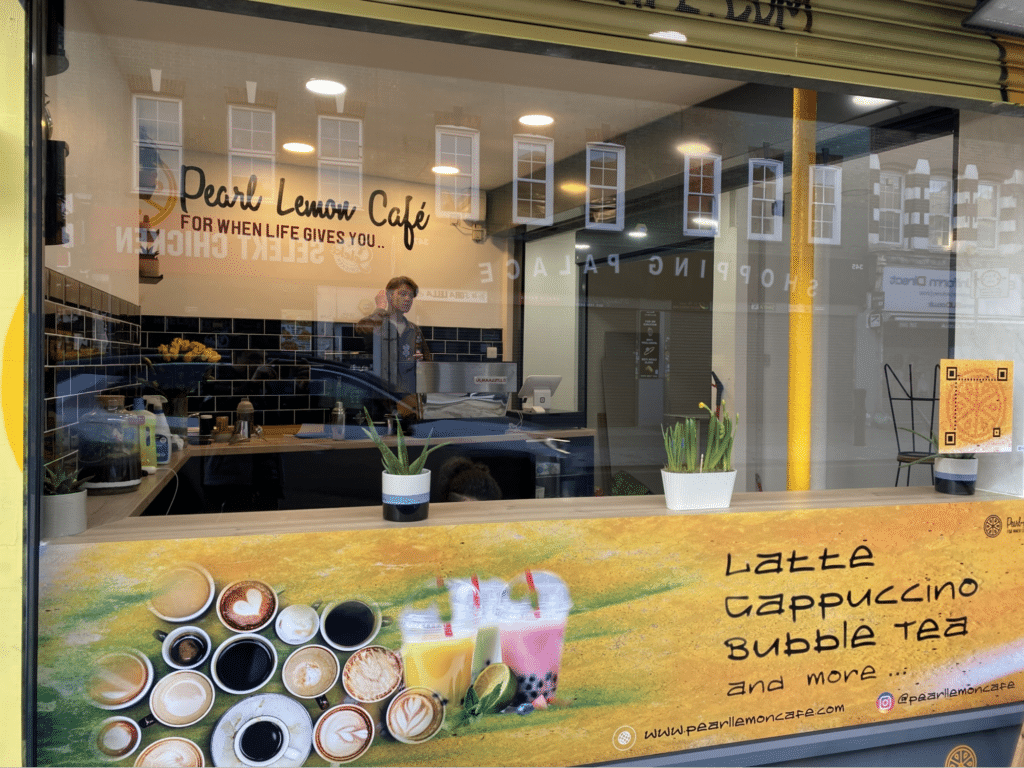
Source: Pearl Lemon Boba
According to statistics, the industry has grown by 6.3% CAGR (Compound Annual Growth Rate) over the last five years in the UK. That’s an impressive 35% growth over the period. The trend continues as millennials demand sweet, customizable dessert drinks and new and exciting cuisines.
There’s no doubt that bubble tea stalls and Asian franchises can be found almost everywhere in Britain,
You can commonly see them with colourful signage, sleek branding, and Instagram-friendly interiors that make them easily recognisable.
But back in 2011, there were barely any bubble tea shops, and the selection was limited. And most of them weren’t even appealing to the Asian palette.
More or less, nowadays, the bubble tea industry is still catching up among other beverage markets in the country. However, unlike the USA, the UK bubble tea industry draws in a different set of markets. This industry attracts more diverse people and has a more extensive reach among locals and people across Europe as well.
Perhaps, it is due to the pandemic crisis that started in 2020 that this market has prospered now. Since travel restrictions were placed, native Asian customers could not buy, and Brits, Blacks, and even French built the local market for these stores.
The pandemic paved the way for people to try new things– including bubble tea.
Its popularity is also attributed to the fact that customers can customise their own drinks by asking baristas. Business owners aren’t burdened as much as they think. This is because opening a tea shop costs less than opening a restaurant, and the process is more manageable.
It has even become increasingly common for new shops to offer ever more elaborate drinks.
Nowadays, businesses make bubble tea with loose leaf tea, organic sugars, organic milk alternatives, and even innovative toppings like:
- egg custard pudding,
- grass jelly, red beans,
- crushed Oreos,
- rose petals,
- gold leaf, and
- cheese (which is disdained by many).
Aside from aggressive expansion outside London and deliberately targeting university towns, bubble tea cafes also attract many young people who shun drugs and alcohol.
The State of Bubble Tea Market Today
From 2020 to 2027, bubble tea’s global market size is expected to grow at an 8.9% compound annual growth rate.
Students and working-class people are increasingly consuming tea and coffee as nootropic drinks. As a result, the demand for such beverages is rising due to their zero fat and low-calorie content.
Bubble tea’s popularity is also likely to increase due to the growing popularity of hot beverages. Furthermore, health experts recommend drinking such drinks moderately to improve focus and concentration.
There are various bubble tea flavours, including fruits, chocolate, coffee, and classic. Various flavoured syrups, ice, and sugar are used to prepare these beverages. Bubble tea demand rises due to a rising preference for hot beverages over carbonated drinks.
However, the recent breakdown of Coronavirus (COVID-19) caused cities across the globe to be locked down, which could result in sluggish growth over the next few years.
Product Statistics
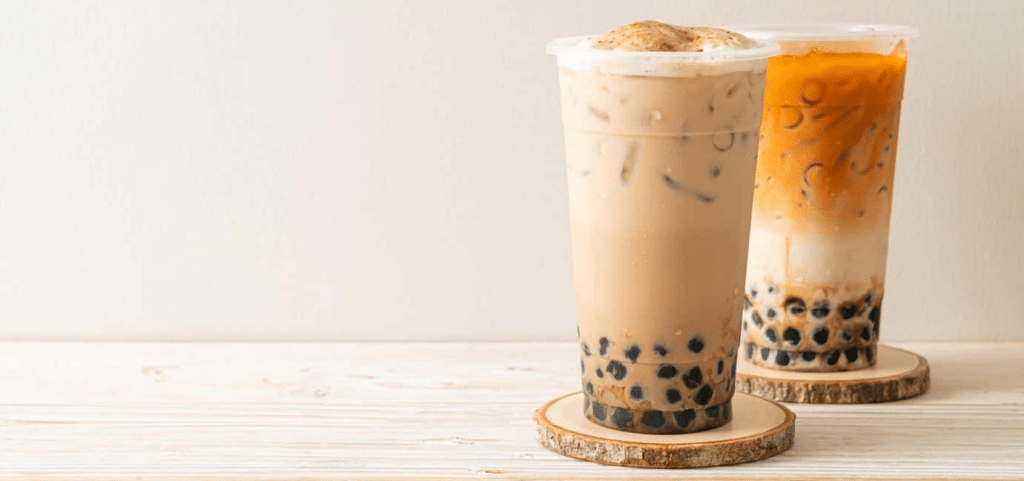
Source: Thee.be
Over 45% of the market share was held by black tea in 2019, which is expected to remain dominant over the forecast period. Due to black tea’s natural flavour, this growth has been attributed to its authenticity. It also lowers blood sugar levels, decreases bad cholesterol, and boosts gut health. Antioxidants are also abundant in it.
Compared to other product segments, green tea is expected to grow the fastest between 2020 and 2027, with a CAGR of 9.2%. Health benefits associated with green tea consumption are likely to drive the growth.
Consumption Statistics
In Southeast Asia, people drink four cups of bubble tea a month on average.
Bubble tea consumption is highest in Thailand, with six cups consumed per person per month, followed by the Philippines with five cups.
Among the countries of Malaysia, Singapore, Vietnam, and Indonesia, three cups are consumed per person per month.
Bubble tea’s most popular flavour in the region is hazelnut, its most popular topping is pearls, and the time when most people order it is lunchtime.
Flavour Statistics
Over the forecast period, the fruit flavour segment is expected to maintain its leading position with a market share of more than 37%. The variety of fruit flavours available is one of the primary factors driving the segment’s growth.
Growing demand for coffee as a healthy energy drink is expected to drive this segment’s CAGR of 9.4% from 2020 to 2027. Coffee is primarily consumed in European and Scandinavian countries. Among the major coffee consumers, Norway consumed 12 kg per capita in 2017.
Worldwide Statistics
Approximately 35% of sales came from the Asia Pacific region in 2019. In the same year, the ASEAN Post reported that Thais consumed six cups of bubble tea per month on average.
As the demand for healthy hot beverages increases, Europe is expected to be the fastest-growing regional market between 2020 and 2027. The European regional market is dominated by the U.K., Germany, and Italy. In the coming years, North America will also have steady growth.
The Social Trend Of Bubble Tea That Dominates The World
We’ve mentioned how bubble tea slowly dominated the world. However, we haven’t really talked about what makes it so trendy.
Written below are the characteristics that we believe are the traits that made bubble tea go phenomenal.
Flexible
The first thing to note about bubble tea is that it is highly adaptable. To suit the consumer’s needs, it can be customised in various ways depending on their preferences.
As far as the sugar percentage is concerned, you can increase or decrease it, add cow or soy milk, make it hot or cold, have it fruity or plain, and make it hot or cold.
This versatility makes it fit every consumer market from all around the world.
Fashionable
There is nothing more creative and trendy than bubble tea. It is most evident in the colourful, foamy, stylish black pearl teas we often see.

Nowadays, foodies love to take the perfect picture for their stories. If they see a beverage such as a bubble tea that looks appetising, just one click on their phones and the beverage will be on their social media accounts.
For this reason, bubble tea companies and businesses pay attention to appearance and use aesthetics in their research.
Additionally, due to stiff competition, boba tea’s quality and variety are increasing.
Innovations in boba tea, like passion fruit jasmine tea, strawberry matcha tea, sugar cane oolong tea, and avocado milk tea, are present.
To develop new appealing flavours and looks, companies and businesses have invested a lot of time and money in consumer research and food engineering.
Convenient
Taiwan’s bubble tea reflects the societal changes that have taken place in the country. It was common for people to savour their hot oolong tea back in the day, but the tea preparation required a lot of time and effort.
There is no doubt that Taiwan’s rapid economic development and industrialisation have pushed its society into a fast-paced lifestyle, where saving time is extremely important. This is why boba tea has become so popular among the younger generation.
When you order a cup of black pearl tea, it will be ready in three minutes. You can then go on your way because your tea is ready.
As it comes in sealed packaging, it has the advantage of being able to be consumed immediately or kept for later drinking.
In addition, the relatively low price point makes it accessible to everyone, no matter where they come from: the working class, the elite or the middle class.
Standardised
The boba tea industry has reached high standardisation over the past few years, primarily led by Taiwanese companies. To ensure maximum efficiency during the preparation process, a Taylorist breakdown of the process is adopted by the industry.

Source: Mashed
Depending on how the ingredients are assembled, one worker will be responsible for assembling them, another will be responsible for mixing them, and a third will be responsible for taking payments.
In addition to that, the preparation process can be measured to improve it. A professional preparation instruction manual will give you information on everything from how long it will take to cook the tapioca balls to how long it will take to shake the drink.
Additionally, technological equipment, such as shaker machines and cup sealers, ensures consistent product and service quality.
Three for Three With Bubble Tea Worldwide
Now that we know how bubble tea started, what made it phenomenal, and its current state, why don’t we look at some of the most prominent bubble tea businesses across the big three nations where it is thriving?
Top Three Bubble Tea Stores in Taiwan
It is a good idea to follow the Taiwanese way of doing things when you are in Taiwan. The city is the birthplace of bubble tea, which is still one of the most popular drinks in the country today.
As it stands, milk tea mania is alive and well, and if you can’t beat ’em, you might as well join ’em!
While in Taiwan, you should try one (or two) Taiwanese milk teas at least once (if not more) while you are there.
As a matter of fact, if you’re planning on indulging, you might as well opt for the best.
Chun Shui Tang
The Taichung branch of Chun Shui Tang is known as the “birthplace of bubble tea”.
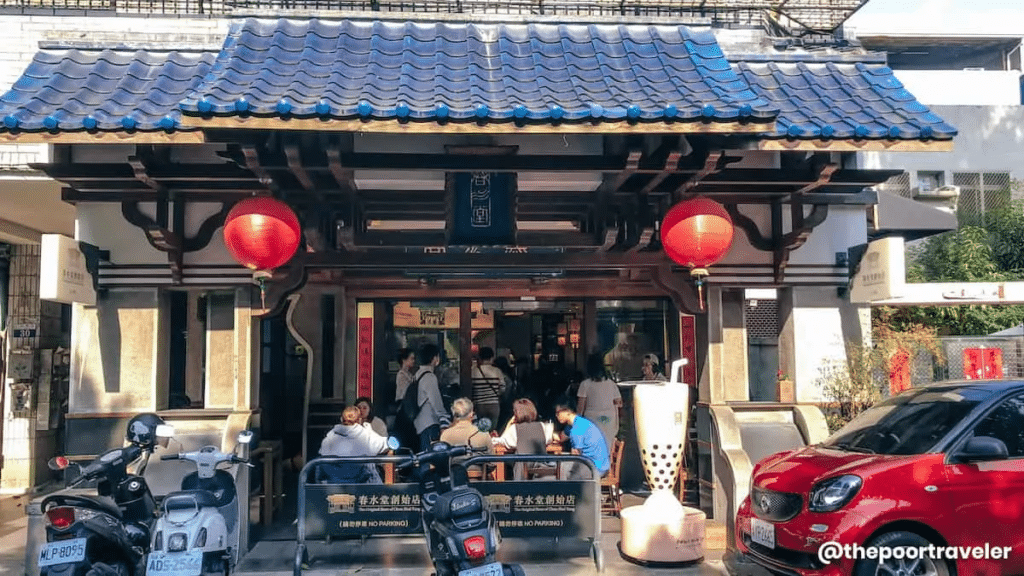
Source: The Poor Traveler
It is widely believed to be responsible for igniting the craze that is currently sweeping the country and even all over Asia in the present day.
Although this restaurant’s menu is quite extensive, it is best to start with the Original Pearl Milk Tea if you are visiting for the first time.
50 Lan
Among the most popular brands of Taiwanese milk tea, 50 Lan is probably one of the most prevalent in the entire country. It offers a variety of milk tea flavours to choose from, as well as some fun concoctions.
At 50 Lan, you can easily enjoy new drinks. This is because every time you go here, there are mix-and-match options that let you make your own drinks!
One of the favourite local drinks is Pearl Milk Tea, a classic milk tea made from pearls and hazelnuts.
SOMA
The SOMA Tea & Mocktail has been making global and international waves in the milk tea game. SOMA has a great selection of milk teas and mocktails and a wide range of Instagram-friendly interiors in Taipei, which is part of its appeal.

Source: Living + Nomads
One of the must-try items from the menu is the Signature Milk Tea, made by blending three different types of premium black tea in a single cup. In addition to skim and almond milk, SOMA also offers a variety of healthier dairy alternatives on request.
Top Three Bubble Tea Stores in The US
People in the U.S. meet regularly at tea shops all across the country to drink bubble tea as part of a social lifestyle.
For several reasons, consumers in the United States have been captivated by bubble tea.
Undoubtedly, this is one of the proud cultural contributions that Asian Americans and Pacific Islanders celebrate and thank during Asian American and Pacific Islander Heritage Month (AAPIHM), which takes place in May each year.
So, if you want to try bubble tea in America, we’ve listed some of the best for you.
Gong Cha
There is no doubt that Gong cha is known across the globe for its signature Milk Foam. A perfect balance of creaminess, sweetness, and savouriness makes it the perfect complement to the freshly brewed tea they serve with it.
They handcraft their delicious milk foam using the freshest milk and the best ingredients.
Coco Fresh Tea & Juice
The CoCo Fresh Tea & Juice Company was founded in Taiwan in the year 1997 and expanded rapidly to China afterwards. There is no doubt that this is China’s first and most prominent chain of fresh beverage outlets.

Source: Everyday is a Food Day
As a result, it has become a recognised brand of boba tea over the past few years.
As the brand dominated China, it began expanding into Hong Kong, Malaysia, Thailand, Indonesia, the United States, and Singapore-all of which were successful.
Coco’s Taro Milk Tea, another delicious variant of their renowned original Milk Tea, is also known for its delicious flavour.
ShareTea
The first Sharetea store opened in Taipei, Taiwan, in 1992, serving Black Tea and Pearl Milk Tea. It was a small tea shop in Taiwan that served a variety of teas and tapioca pearls of high quality.
To deliver the best boba tea flavour combinations, Sharetea uses premium ingredients. It is also important to them to ensure that every ingredient in their beverages is of the highest quality.
You will love the best-selling Kiwi Fruit Tea with the Aiyu Jelly and the Hawaii Fruit Tea for a taste of the tropics!
Top Three Bubble Tea Stores in The UK
Apparently, from the narrative we’ve discussed earlier– the UK is a promising location for bubble tea!

Source: Takeaway Packaging
Apparently, that’s why we’re here!
So if you want to get the best of the best bubble tea in the UK, then visit some of these well-known shops.
Biju Bubble Tea Room Soho
If bubble tea is your thing, Biju Bubble Tea Room Soho is a must-visit in London. Customers receive bubble tea made with the best ingredients.
Fresh organic ingredients are always used in brewing, and the beverage is never stewed. It is made from milk and delicious fruit nectar, making it even tastier.
Assam black, Thai, and chai milk tea are some of the crowd’s favourites.
Gonuts Bubble Tea London
A visit to Gonuts Bubble Tea London will not disappoint if you seek some of the city’s best bubble tea.
Going nuts over gonuts is what this shop is all about. Enjoy some amazing drinks here while being spoilt for choice.

Source: Foursquare
You can also use the store’s WiFi access and play free board games for your complete entertainment. In addition to its rose tea, milk tea with bubbles, and green tea, you can also find a variety of other teas there.
T4 Westfield London
Here is a Taiwanese shop in London that has become a favourite. Founded a couple of years ago, it has already carved out a niche in the market.
Besides serving authentic Taiwanese bubble tea, this place is also known for its excellent service and fun atmosphere. You can’t go wrong with French pudding milk tea.
You can expect nothing but fresh drinks here, so it’s worth waiting for your favourite drink.
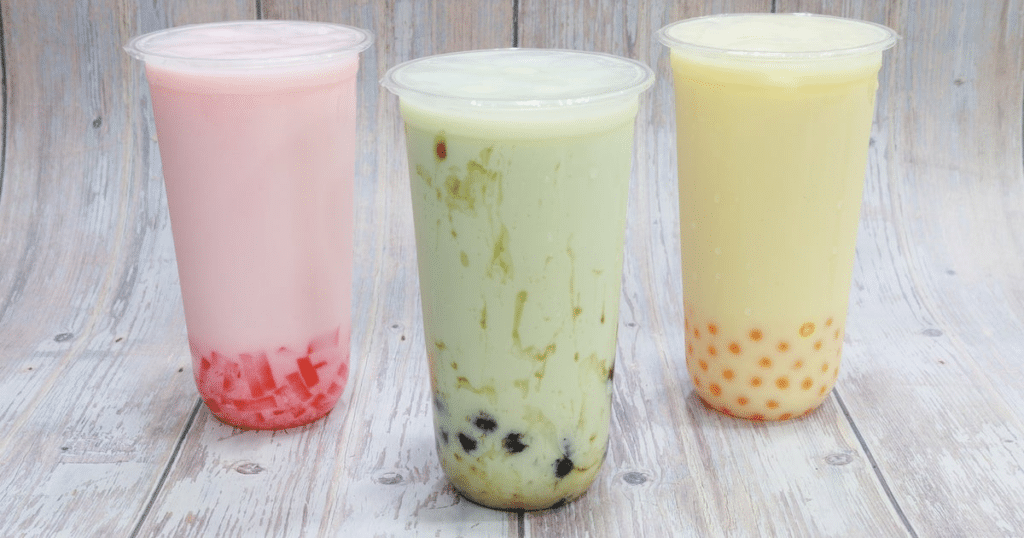
If you happen to visit these stores in London, you might as well visit Pearl Lemon Boba too!
We’re a rising crowd favourite at North End Road, and our baristas will be more than welcome to make your drink upon request!
The Bubble Teas For Everyone Who Likes Boba
Now that you know which stores make the best milk tea across the US, UK, and Taiwan– why not learn more about what classic milk tea and fruit tea are all about?
We’ll even pitch in recipes for it!
Classic Milk Tea
Originally from Taiwan, classic milk tea is one of the most popular bubble tea flavours.
As the original boba tea flavour, classic milk tea is what started it all for boba tea lovers everywhere. It is a treat consisting of black tea, milk, brown sugar, and of course, the famous black tapioca balls we all love to munch on!
Classic milk tea has a lot to offer: it’s creamy, sweet, and utterly delightful!
Taking black tea and brown sugar together creates an amazing flavour combination that you should try at least once in your life. The chewy tapioca pearls for this drink are infused with brown sugar for additional sweetness.
If you’re wondering what it looks like, it’s actually pretty normal.
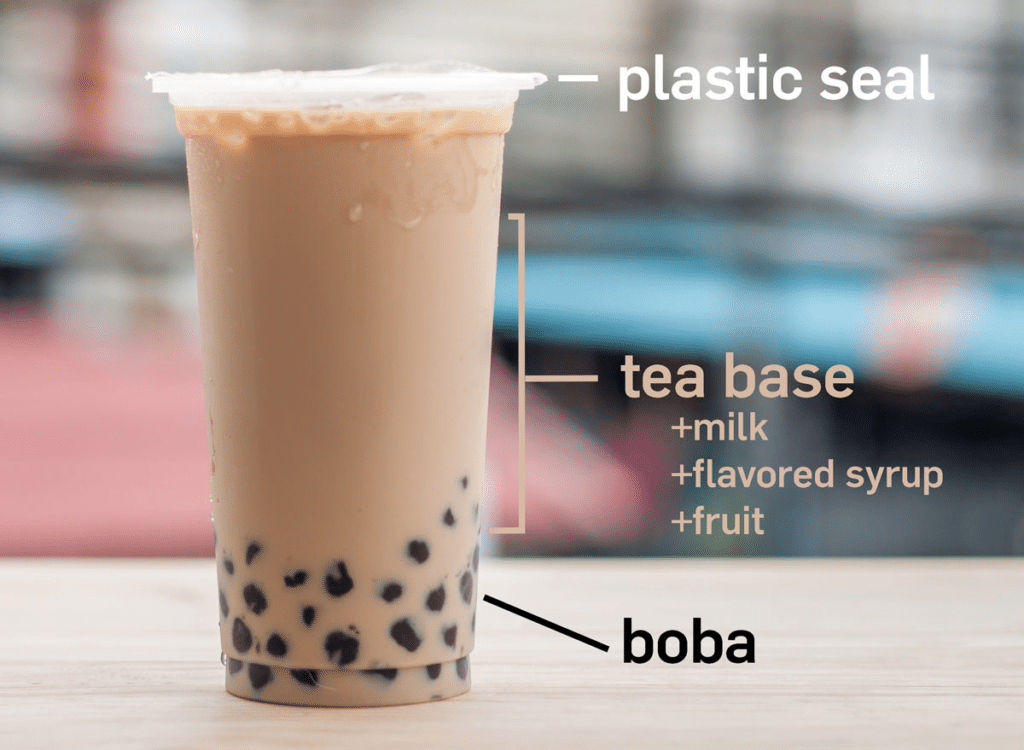
Source: Eat This, Not That
There are several types of milk, but the one used for classic milk tea is opaque. This is why the drink is usually beige or light brown in colour. It then gives the beverage a thick and creamy texture.
Baristas add cream or milk to the base of black tea to make it look more appetising. And at the bottom of your boba tea cup, you will also see a thick layer of black or brown tapioca pearls, calling you to drink it.
As the terminology used in bubble tea is not very consistent and can confuse some people, some people sometimes add the word classic to the term “bubble tea”.
There are many ways in which bubble tea is referred to, such as boba, boba tea, milk tea, pearl milk tea, and so on. To ensure that bubble tea is distinguishable from the general boba tea term, “classic” is added beforehand.
The Classic Milk Tea Recipe
These are the things you’ll need to make a classic milk tea for 2:
Equipment
- Teapot/Tea Strainer
- Medium Pot
- Slotted Spoon
- Pitcher
- Boba Cup
- Boba Straws
Ingredients
- Ice
- 2 Cups Cold Water
- 4 Tsp Black Tea Leaves/ 3-4 Tea Bags
- 10 Tso Brown Sugar
- 1 Cup Milk
- 1 Cup Tapioca Pearls
Recipe
- Prepare your tapioca pearls by boiling them in a small saucepan on medium heat. Boiling times vary depending on the package. It is recommended that your boba pearls be firm and not mushy.
- Brown sugar syrup should be prepared while tapioca pearls are boiling. To prevent your boba pearls from sticking together, you’ll store them in this brown sugar syrup. The process involves adding 6 tsp of brown sugar to 1 cup of hot water in a bowl. Make sure the sugar dissolves well by stirring consistently.
- The brown sugar syrup should be added after draining the boba pearls.
- In a pot of nearly boiling water, mix 4 tsp of black tea with 2 cups of water. Let it sit for 3-5 minutes.
- Add the black tea to the pitcher along with milk and 4 tablespoons of brown sugar after it has brewed. Make sure your black tea mixture is well-mixed.
- The boba pearls can be added to your favourite reusable boba cup. It is up to you to control how much milk tea you add. You can add up to 1 inch of milk tea.
- Adding ice to your boba cups is optional (to taste).
- Take two cups of black tea mixture and divide it between them.
- Now you have two cups of bubble tea– enjoy!
Fruit Bubble Tea
Another crowd favourite among bubble tea is what we call fruit tea or fruit bubble tea.
The simple fruit bubble tea recipe consists of your favourite fresh, frozen, or pureed fruit blended with milk or almond milk, honey, and ice cubes.
It is fruity heaven when you pour it over boba.
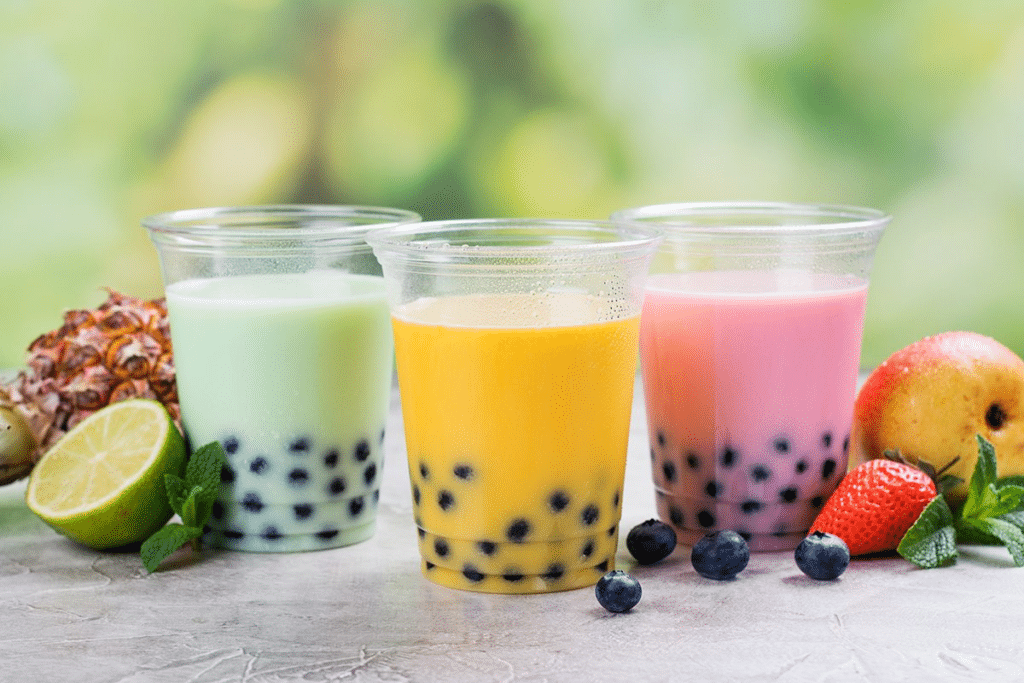
Source: Taste of Home
Many people enjoy Fruit Bubble Tea. Those all-natural flavours of peaches, strawberries, raspberries, and pineapple give this drink an extra sweet note– and mind you, these aren’t the only fruits you can put in.
These amazing flavours are made possible by the quality of the fruit used. Hence, many people are passionate about providing only the highest quality products. Bubble tea isn’t complete without a delicious fruity topping.
It is possible to make delicious Bubble Fruit Tea with Bubble Tea Fruit Pearls. Depending on your taste, you can choose either green or black tea as a base and add fruit syrup. For a tasty combination, choosing fruit pearls in one or more flavours is possible.
The Fruit Bubble Tea Recipe
These are the things you’ll need to make a fruit bubble tea for 2:
Equipment
- Blender
- Teapot/Tea Strainer
- Medium Pot
- Slotted Spoon
- Pitcher
- Boba Cup
- Boba Straws
Ingredients
- Ice
- 2 Cups Cold Water
- 4 Tsp Black Tea Leaves
- 1 Cup Choice of Fruit
- 1 Cup Milk
- 1 Tbsp Honey
- 1 Cup Fruity Tapioca Pearls
- 2 Tbsp Fructose of Choice
Recipe
- Follow the basic instructions for preparing your boba and tea from the classic milk tea recipe above.
- Blend the fruit, milk, ice, and honey together when the mixture is ready. You need to blend until smooth.
- Prepare the boba and place it on the bottom of your boba cup.
- Pour your smooth blended mixture into the two cups.
- Enjoy!
Other Bubble Teas
There are also other bubble teas that many people enjoy. Some of them are:
- Thai Bubble Tea
- Taro Bubble Tea
- Cheesecake Bubble Tea
- Salted Cream Bubble Tea
There are also other variations that are emerging everywhere; it’s just a matter of time before everyone discovers it.
The Teas Commonly Used For Bubble Tea
Bubble tea is traditionally made from tea leaves, as its name implies.
And while black tea is the most prevalent bubble tea base, other options are available at some locations.
So, if you ever thought that only one specific tea is used for your bubble tea– you’re wrong.
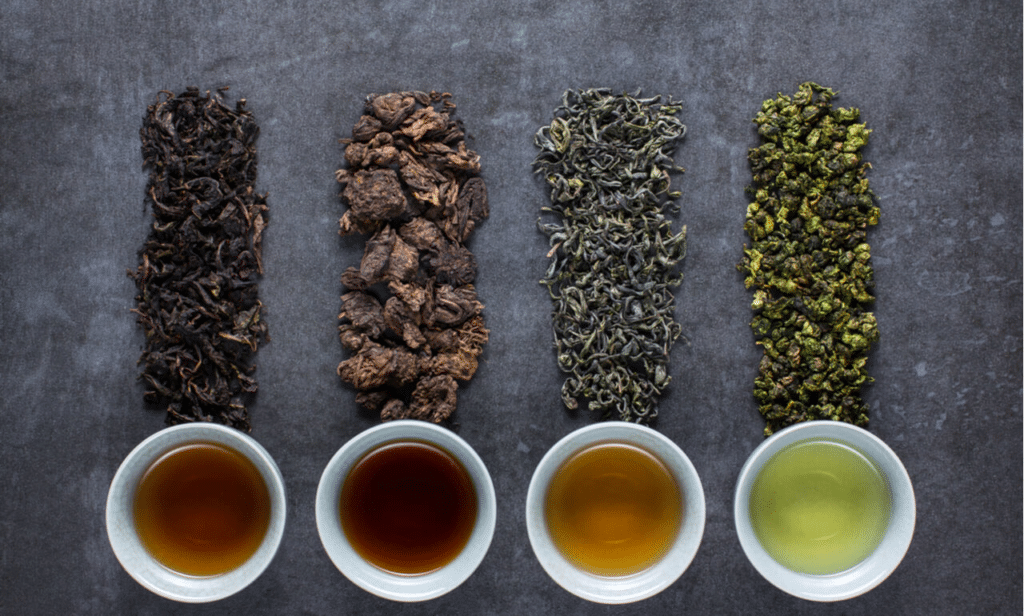
Source: HealthifyMe
Here are different types of tea that every business may use:
- Black Tea: In China, Hong Kong, and Taiwan, this tea is called red tea. Alongside Earl Grey, it is the most common tea choice for boba.
- Green Tea: The most common type of green tea is jasmine green tea or matcha green tea powder.
- Oolong Tea: Many bubble tea drinkers prefer traditional oolong tea, but green oolong is also popular.
- White Tea: In Taiwan, white tea is rarely used for bubble tea, despite the fact that it is a relatively popular choice in some western countries.
If those are too general for you, then here are some of the best teas that make an excellent boba blend:
Assam
In India, the Assam region is known for producing robust black tea, which is why this tea is called Assam.
There is no doubt that Assam is a favourite choice of tea among milk tea drinkers due to its full body and notes of malt and spice. Many blends, such as Masala Chai and Irish Breakfast, include Assam.
Ceylon
There is no doubt that Ceylon black tea is a hearty black tea that will go well with milk and sugar. As the name suggests, it comes from Sri Lanka, which used to be known under British colonial rule as Ceylon.
An organic Ceylon black tea is rich, smooth, and highly aromatic tea. It makes a very refreshing, brisk cup of boba with just a bit of spice to add to it.
Nilgiri
Nilgiri tea is a black tea grown in the southern Indian region of Nilgiri and is named after the region where it is grown. The strength of the Niligiri tea isn’t quite as strong as Assam, but it has a full body that can still be enhanced by adding milk or sugar to it.
In addition to its subtle notes of honey and stone fruit, Nilgiri is a beautiful copper-coloured tea that brews very well.
Star of India
Assam, Darjeeling, and Nilgiri teas are actually blended together to make Star of India black tea, which is primarily an Indian blend.
From the robust Assam, the dark, mellow sweetness of Nilgiri teas, and the subtle astringency of the Darjeeling teas, this creative blend gains strength and body.
English Breakfast
The English Breakfast black tea combines Ceylon, Assam, and Tanzanian black teas that impart a hearty, balanced blend of flavours with a hint of sweetness from the tea leaves.
The English Breakfast tea is designed to be enjoyed with milk and sweetener on a rainy day because it is the perfect cosy cup of tea to warm your soul and yourself.

Source: Simple Loose Leaf
Irish Breakfast
It is a blend similar to English Breakfast tea, and it contains Assam, Ceylon, and Tanzanian black teas, which are all black teas that are derived from Southeast Asia. Having been finely ground, Irish Breakfast tea is exceptionally strong, full-bodied, with hints of malt and spice, and produces a very strong, full-bodied cup of tea.
If you are looking for a tea that is perfect for making a cup of Hokkaido milk tea or even just to drink it with a splash of milk and honey, this is the tea for you.
Vietnamese Gold Tips
Despite its lack of fame, Vietnam is an up-and-coming tea-producing nation. As one of the best Vietnamese black teas, this Vietnamese Golden Tips has a detailed aroma, a full body, a dry finish, and notes of burnt sugar and caramel notes.
To produce this tea, Shan Tuyet tea trees over 50 years old were used, which are a part of a heritage tea tree plantation. Talk about ancient!
Flavoured Black Teas
A variety of milk teas can also be made using flavoured black teas. It is essential to know that these teas contain additions to the black tea base, such as fruits, flowers, and spices.
Black teas with flavours such as Masala Chai, Earl Grey, and Vanilla Velvet are among the most popular black teas that go well with milk.
Matcha
Compared to ceremonial grade matcha, culinary grade matcha has a slightly stronger flavour. There is no doubt that this tea’s grassy, slightly sweet taste will hold up to the addition of milk and cream without losing any of its strength.
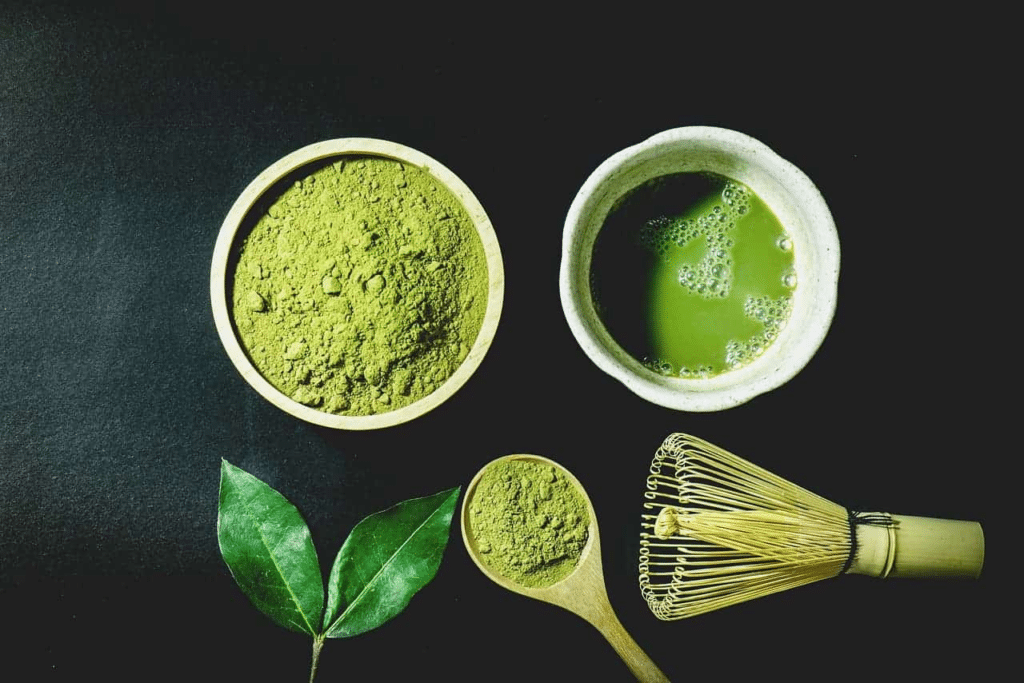
Source: ZME Science
Often, honey or simple syrup is used to sweeten matcha bubble tea, and a milk frother or electric whisk can be used to make frothy matcha lattes.
But remember, we’re not limiting you to these teas– you can go on and experiment on others too!
Let us know if you have any other tea that you think is perfect for a milk tea blend!
Different Types of Boba Pearls For You To Know
The boba that’s used in bubble tea is probably familiar to you if you enjoy the drink.
The bobas are made from a type of tapioca pearl and are sometimes called the bubbles at the bottom of bubble tea drinks.
Boba is available in a number of varieties today.
Clear Boba
The typical boba pearls come from the roots of the cassava plant, a starchy tuber closely related to the yam and contains a lot of starch.
While making tapioca pearls, cassava starch is compressed into balls that are then formed into pearls with the help of an electric machine. The clear colour of traditional bobas makes them a great choice for making bright, fun colours that stand out on the drink.
Black Boba
A popular choice of tapioca pearls in bubble tea drinks is the black bobas, which are dark-coloured tapioca pearls. To give them their dark colour, caramel colouring or brown sugar are added to the same recipe as clear bobas.
Flavoured Boba
Different flavours of boba pearls are available in some places to boost the diversity of boba pearls. Flavoured bobas are tapioca pearls boiled or covered in flavoured syrup.
The flavour options for these pearls are virtually limitless, but some popular flavours include honey, watermelon, peach, and strawberry.
Popping Boba
Popping boba was created to take the notion of flavoured tapioca balls a step further. This boba flavour contains fruit juice.

Source: Bubble Tea Training
When you start biting into a popping boba, the sweet fruit juice bursts on your tongue, offering a different sensation and flavour. Bananas, raspberries, pineapple, and strawberry are some of the most popular flavours of popping boba.
Mini Boba
Traditional boba is about 8mm when finished cooking. Mini bobas seem to be, as the name suggests, much tinier. Mini bobas are roughly half the size of usual boba, which means they cook quicker and in a shorter period of time. Mini bobas may be easier to chomp down for some people than bigger bobas.
However, if you’re not really a fan of boba pearls, there are other alternatives you can choose from.
Here at Pearl Lemon Boba, for instance, we offer alternative toppings like flavoured jelly and aloe vera!
The Favourite Bubble Tea Flavours Across the Globe
Given that you already know by now how to make classic milk tea or fruit bubble tea, the ingredients used, and everything else– we also want you to learn which flavours are the crowd’s favourite worldwide!
Black Milk Tea
There is no doubt that the classic milk tea flavour (black milk tea) and boba choice are iconic classics. Some consider them to be the grandfather of bubble tea and boba. Initially, this flavour was the starting point, and within a few years, many other flavours followed.
As far as bubble tea flavours go, this is undoubtedly the most popular.
Classic milk tea is one of the first flavours of milk tea, and it’s easy to make at home. Perhaps that’s also one of the reasons why a lot of people like it.
Taro Milk Tea
Can you recall seeing someone sipping on purple bubble tea like there was no tomorrow? It might be one of our baristas, sorry about that!
Regarding flavour selections, taro milk tea is one of the best, if not the best. The creaminess, taste, and refreshingness make it a great choice. A taro root powder mix is typically used in the production of this type of boba, as well as in smoothies and bubble tea.

Source: Coffee Affection
There’s nothing crazy about the taste of this flavour, but it’s addicting. Some say it offers a richer vanilla nut taste than a vanilla milkshake or latte.
That’s why we offer taro on our amazing menu here at Pearl Lemon Boba!
Thai Milk Tea
In addition to its sweet, creamy, and orange flavour, this iced Thai milk tea is silky in texture and flavourful throughout. A better black milk tea than you’re used to.
It features a blend of sweetness, mild spice, earthiness, and floral notes and is reminiscent of Southeast Asian dishes like Pad Thai and Massman curry. It is, of course, the tea that dominates the flavour of Thai milk tea.
Thai milk tea’s unique flavour comes from spices. Spices commonly used to spice Thai milk tea are crushed tamarind seeds, star anise, and cardamom. Along with these spices, Thai milk tea may also contain orange blossom water. The bitter orange blossoms are used to make this oil.
Try it out, and let us know what you think– who knows? Maybe we can add it to our selection for you!
Matcha Milk Tea
Aha! Another crowd favourite from our menu. Matcha milk tea is adamantly one of our best sellers.
It is hard to ignore the popularity of this bubble tea flavour; even coffee shops have this flavour for lattes and other drinks. This is very true! In fact, we’re proof of this because we have a sister store named How Matcha that serves beverages and snacks with matcha!
As you can see, this flavour is indeed another all-time classic, and the boba drink isn’t an exception from its vibrant earthy green aura.
Needless to say, matcha boba is made from matcha powder, tea, a splash of your choice of milk, honey, and the ever-loved boba pearls.
Matcha milk tea is a popular choice among those seeking a familiar taste. When your matcha milk tea has a creamy texture and a deep flavour, you know it’s good.
Don’t forget to get one from us next time you’re out for bubble tea! We guarantee that you’ll get the best blend ever.
Honeydew Milk Tea
If you think every milk tea is made from powdered mixtures, you’re guessing it wrong. Some milk teas are made from the concentrated fructose of fruits– and that’s what we do here at Pearl Lemon Boba.
The long find is over because we’re here with refreshments that are made from fresh produce. One of our astounding bestsellers, in fact, is honeydew milk tea!
It’s Assam milk tea blended with honeydew fruit juice to get that melony taste.
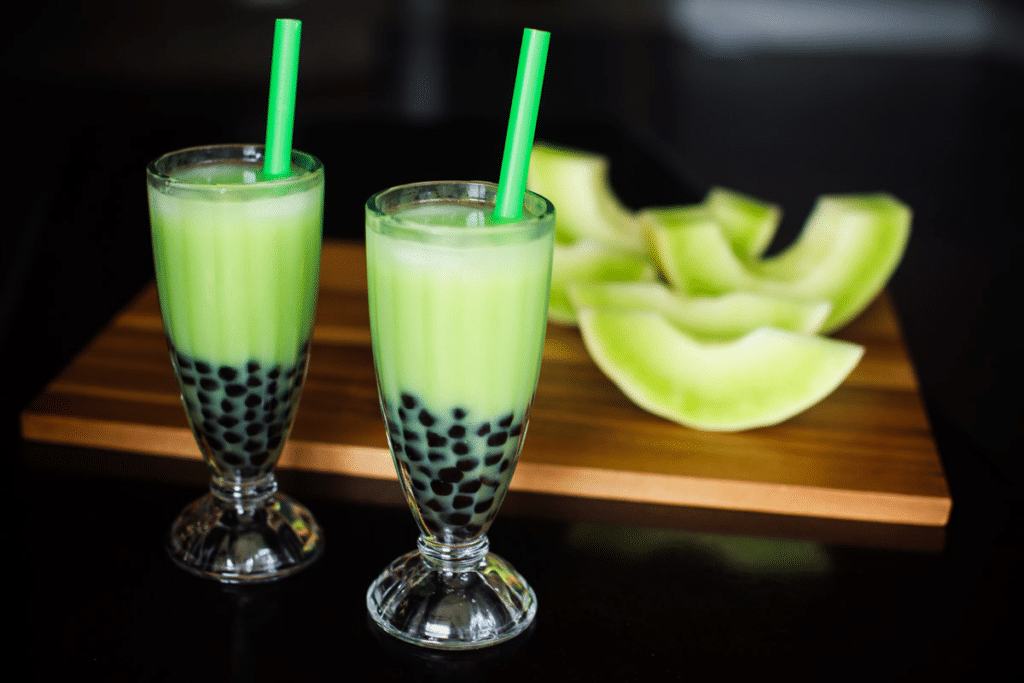
Source: FOOD is Four Letter Word
This bubble tea is delicious and refreshing because of its unique melon flavour and slight sweetness from fresh honeydew.
Honeydew tea is a good choice for those who enjoy lightly sweet milk tea.
Strawberry Milk Tea
It wouldn’t be right to leave out the staple strawberry drink. That’s why we also added it to our selection!
Strawberry milk tea is an all-around favourite, so what’s a bubble tea selection without it? The perfect combination of creamy and berry in one drink!
The main ingredient is strawberry, which can either be powdered or fresh. But for us, fresh strawberries are clearly the best way to go.
In our experience, when it comes to bubble tea, we prefer to make it thick and creamy in texture, almost like a strawberry smoothie with tapioca pearls. Indeed, what a delicious treat!
Tiger Milk Tea
Last but not least, we saved the most popular boba flavour for last. It is a bummer if you haven’t tried brown sugar or tiger milk tea yet!
Tiger Sugar in Taiwan introduced this flavour a couple of years ago and made it famous. As time went on, it gained popularity in the US and Western culture for everyone to enjoy.
This was a massive hit with everyone; some even got heavily addicted to it. A popular ice cream bar was also created from this flavour, and it is often sold out in supermarkets because it is so popular.
Although we’re not serving this one yet– give us a few more months, and you’ll see it on our boards!
A Bubble Tea Drink For Everyone From Pearl Lemon Boba
Whoo! Now that’s just information overload– we know!
But it’s really helpful to understand and know the roots of bubble tea– especially if it’s rich in culture, tradition, and wisdom.
Evident enough, throughout history, England is known for its famous teas– a staple that Brits bloody love throughout every generation. If you enter the home of an English man, he would often ask you:
“Would ya like a cuppa tea?”
But kidding aside, the love for tea throughout the years has now reached new heights– an innovation called bubble tea.
With all of its variations, people now enjoy tea in whatever flavour they like!
Here at Pearl Lemon Boba, we honour generations of traditions and recognise the important meaning of boba tea.
We also believe that it’s more than just a drink. It’s part of why we started this business.
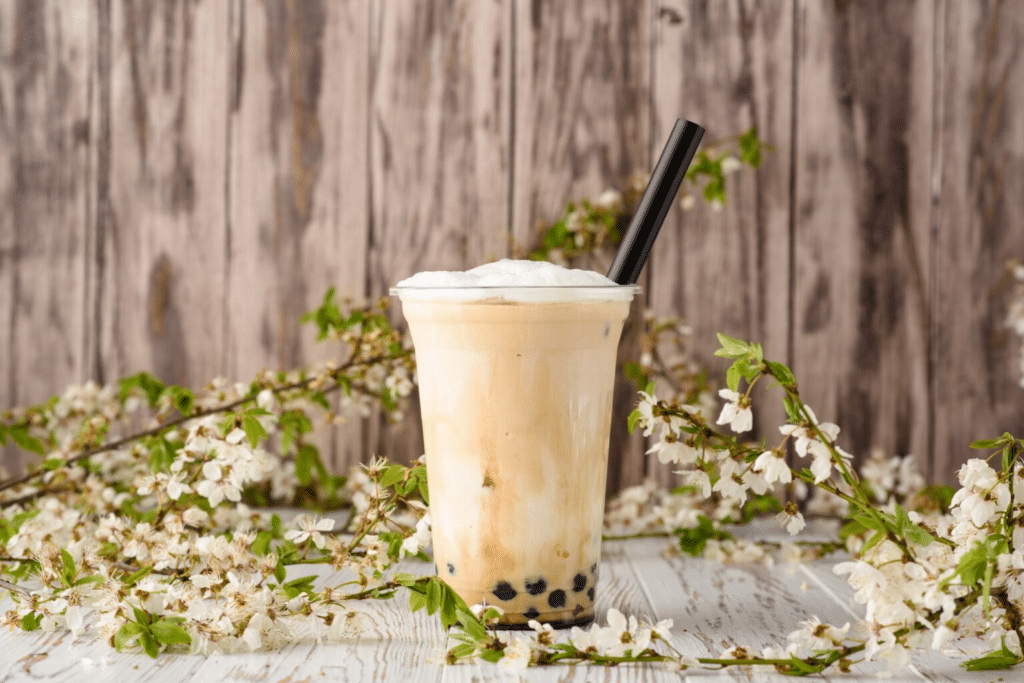
Despite its reputation as a traditional Taiwanese treat, bubble tea is accessible to everyone. There are many bubble tea shops worldwide, but Pearl Lemon Boba crafts the freshest and finest bubble tea Fulham offers.
The first thing we did was reject the idea of brewing large quantities of tea with powdered bases. That’s why we prepare boba tea fresh on demand and add fresh milk to every cup.
After all, choosing the right ingredients is the first step toward making a great cup of tea.
Boba tea brings smiles to people and gathers diverse people in one place while enjoying something tasty, sweet, and extraordinary. Who wouldn’t want a place like that?
Visit Pearl Lemon Boba today at Unit Number 4, Building Number 250 North End Road, SW6 1NJ, United Kingdom. See you!
FAQs
What’s so special about bubble tea?
Boba is a unique drink combining sweet tea with chewy tapioca balls. While iced coffee and juice have the same consistency, boba offers a sort of break from the same monotonous texture. You won’t find a drink like it anywhere else.
Are tapioca pearls healthy for you?
Tapioca pearls really can’t be categorized as healthy or unhealthy because they can get very subjective. The pearls we see in bubble tea– tapioca pearls– are usually made with cassava starch. It contains empty calories.
Essentially when you hear the word starch, you’d think it would have carbohydrates for energy consumption of the body. Tapioca has carbs but doesn’t have any nutritional value for your body. So if taken as it is, without the sweeteners, they are about 100 calories for every 1/4 cup.
How to start a bubble tea business?
It can be tough to start your own bubble tea business. Every business from the ground up is relatively hard to do.
But there are other ways you can go about it, like starting a franchise business! Here at Pearl Lemon Boba, we offer business-minded people like you the opportunity to work with a brand already established in London.
If you want to know more about how you can get a franchise of our cafe, just click HERE.

